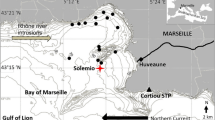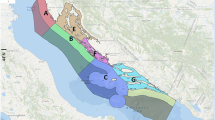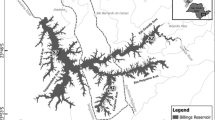Abstract
This preliminary study investigated the diet composition and diet overlap for both Sardina pilchardus and Sardinella aurita, as well as the zooplankton distribution (with a special focus on copepods) in the representative region of Algiers coast (Bou Ismail Bay) during a short period on June 2015. This month can be considered representative of the summer (and autumn) season (s), since between the two periods, the meteorological characteristics remain homogeneous. The study area, is considered one of the most prestigious bays on the Algerian coast, regarding fisheries production. At the level of the food web, trophic interactions link predators (fish populations) to zooplankton prey. At Bouharoun port, also located in the bay of Bou Ismail, samples were obtained from commercial fisheries of S. pilchardus and S. aurita. Additionally, zooplankton samples were collected vertically in the 0-100 m layer. Based on stomach content analysis, significant diet overlap was observed between S. pilchardus and S. aurita (Schoener index : D = 0.76) indicating similar feeding habits (Morisita-Horn index: O = 0.94). Copepods were preferential prey for both fish species with high frequencies (F Saurita = 91.66%, FS.pilchardus = 85%). Their highest average number found in the diet of S. aurita was represented by Centropages typicus, followed by Centropages chierachiae and Temora stylifera; while Nannocalanus minor was mainly consumed species by S. pilchardus. Copepod populations were dominant in S. pilchardus and S. aurita feeding strategies. A total of 22 copepod species were identified in the water column, mostly in the Calanidae. Their distribution varied significantly across stations (p = 0.046); three species (T. stylifera, C. typicus and C. violaceus) contributed mostly to this variation. Copepods have a relationship with environmental parameters (e.g., temperature, chlorophyll a, and NO3).








Similar content being viewed by others
Data Availability
All the data analysed during this study are included in this published article.
Change history
06 March 2024
A Correction to this paper has been published: https://doi.org/10.1007/s41208-024-00685-3
References
Alheit J, Roy C, Kifani S (2009) Decadal-scale variability in populations. Climate Change Small Pelagic Fish 64–87. Cambridge University Press
Ali L, Bachari N, Mokrane Z (2021) Small pelagic fishery statistics on the central Algerian coast (SW Mediterranean) combined with satellite abiotic data. Proceeding of the IVth International Conference on Data Science and Applications (ICONDATA’20) Turkey
Amundsen P (1996) A new approach to graphical analysis of feeding strategy from stomach contents data—modification of the Costello (1990) method. J Fish Biol 48:607–614. https://doi.org/10.1006/jfbi.1996.0060
Antell GS, Saupe EE (2021) Bottom-up controls, ecological revolutions and diversification in the oceans through time. Curr Biol 31:R1237–R1251. https://doi.org/10.1016/J.CUB.2021.08.069
Baali A, Ouazzani KC, Touhami F et al (2020) Diet composition of round sardinella (Sardinella aurita) and flat sardinella (Sardinella maderensis) in the south of atlantic Moroccan coast. Egypt J Aquat Biol Fish 24:73–91. https://doi.org/10.21608/ejabf.2020.119032
Babouri K, Grazia Pennino M, Bellido JM (2014) Herramientas basadas en indicadores tróficos para la implementación del enfoque ecosistémico en pesquerías con escasez de datos: Ejemplos De Argelia Y Bahía Bou-Ismail. Sci Mar 78:37–51. https://doi.org/10.3989/scimar.04023.19B
Bacha M, Amara R (2009) Spatial, temporal and ontogenetic variation in diet of anchovy (Engraulis encrasicolus) on the Algerian coast (SW Mediterranean). Estuar Coast Shelf Sci 85:257–264. https://doi.org/10.1016/j.ecss.2009.08.009
Bacha M, Amara R (2012) Inter-cohort differences in growth, condition and feeding of juvenile anchovy (Engraulis encrasicolus) in the Gulf of Béjaia (Algerian coast, SW Mediterranean): implications for recruitment success. Fish Res 129–130:73–81. https://doi.org/10.1016/j.fishres.2012.06.012
Bachiller E, Giménez J, Albo-Puigserver M et al (2021) Trophic niche overlap between round sardinella (Sardinella aurita) and sympatric pelagic fish species in the Western Mediterranean. Ecol Evol 11:16126–16142. https://doi.org/10.1002/ece3.8293
Bahar B, Tuncay S, Murat K (2015) Feeding of the round sardinella Sardinella Aurita Valenciennes, 1847 (Osteichthyes: Clupeidae) in the Turkish Aegean Sea. Int J Fauna Biol Stud 2:38–42. https://doi.org/10.3389/conf.fmars.2015.03.00256
Bai ML, Lin FS, Lee YC et al (2015) Research open accesstrophic structure of the pelagic food web in the East China Sea. Zool Stud 54:1–9. https://doi.org/10.1186/s40555-014-0089-0
Bedairia A, Djebar AB (2009) A preliminary analysis of the state of exploitation of the Sardine, Sardina pilchardus (Walbaum, 1792), in the gulf of Annaba, East Algerian. Anim Biodivers Conserv 32:89–99. https://doi.org/10.32800/abc.2009.32.0089
Benedetti F, Gasparini S, Ayata SD (2015) Identifying copepod functional groups from species functional traits. J Plankton Res 38:159–166. https://doi.org/10.1093/plankt/fbv096
Borcard D, Gillet F, Legendre P (2018) Numerical Ecology with R, 2nd edn. Springer International Publishing
Bouaziz A, Kerzabi F, Brahmi B (2014) Impact of the natural mortality (m) variability on the evaluation of the exploitable stock of sardine, Sardina pilchardus (Actinopterygii: Clupeiformes: Clupeidae) of the central region of the Algerian coast. Acta Ichthyol Piscat 44:87–97. https://doi.org/10.3750/AIP2014.44.2.01
Castellani C, Robinson C, Smith T, Lampitt RS (2005) Temperature affects respiration rate of Oithona similis. Mar Ecol Prog Ser 285:129–135. https://doi.org/10.3354/meps285129
Catalán IA, Folkvord A, Palomera I et al (2010) Growth and feeding patterns of European anchovy (Engraulis encrasicolus) early life stages in the Aegean Sea (NE Mediterranean). Estuar Coast Shelf Sci 86:299–312. https://doi.org/10.1016/j.ecss.2009.11.033
Champalbert G (1996) Characteristics of zooplankton standing stock and communities in the western Mediterranean Sea: relations to hydrology. Sci Mar 60:97–113
Chaouadi M, Hafferssas A (2018) Seasonal variability in diversity and abundance of the free-living pelagic copepod community of the Algerian coasts (SW Mediterranean Sea). Crustaceana 91:913–946. https://doi.org/10.1163/15685403-00003805
Checkley DM, Dickson AG, Takahashi M et al (2009) Elevated CO2 enhances otolith growth in young fish. Sci 324(80):1683. https://doi.org/10.1126/science.1169806
Chiba S, Saino T (2003) Variation in mesozooplankton community structure in the Japan/East Sea (1991–1999) with possible influence of the ENSO scale climatic variability. Prog Oceanogr 57:317–339. https://doi.org/10.1016/s0079-6611(03)00104-6
Chouvelon T, Chappuis A, Bustamante P et al (2014) Trophic ecology of European sardine Sardina pilchardus and European anchovy Engraulis encrasicolus in the Bay of Biscay (north-east Atlantic) inferred from δ13C and δ15N values of fish and identified mesozooplanktonic organisms. J Sea Res 85:277–291. https://doi.org/10.1016/j.seares.2013.05.011
Christou ED (1998) Interannual variability of copepods in a Mediterranean coastal area (Saronikos Gulf, Aegean Sea). J Mar Syst 15:523–532. https://doi.org/10.1016/S0924-7963(97)00080-8
Costalago D, Palomera I (2014) Alimentación De La sardina Europea (Sardina pilchardus) en El Mediterráneo noroccidental: De Post-larva a adulto. Sci Mar 78:41–54. https://doi.org/10.3989/scimar.03898.06D
Cury P, Bakun A, Crawford RJM et al (2000) Small pelagics in upwelling systems: patterns of interaction and structural changes in wasp-waist ecosystems. ICES J Mar Sci 57:603–618. https://doi.org/10.1006/jmsc.2000.0712
Dahel A, Tahri M, Bensouilah M et al (2016) Growth, age and reproduction of Sardinella aurita (Valenciennes, 1847) and Sardina pilchardus (Walbaum, 1792) in the Algerian eastern coasts. AACL Bioflux 9:1172–1181
Di Capua I, Mazzocchi MG (2004) Population structure of the copepods Centropages typicus and Temora stylifera in different environmental conditions. ICES J Mar Sci 61(4):632–644. https://doi.org/10.1016/j.icesjms.2004.03.007
Di Carlo BS, Ianora A, Fresi E, Hure J (1984) Vertical zonation patterns for mediterranean copepods from the surface to 3000 m at a fixed station in the Tyrrhenian Sea. J Plankton Res 6:1031–1056. https://doi.org/10.1093/plankt/6.6.1031
de Fernández ML, Pinot JM, Valencia J (2003b) Seasonal and interannual variability of zooplankton community in waters off Mallorca island (Balearic Sea, Western Mediterranean): 1994–1999. Oceanol Acta 26:673–686. https://doi.org/10.1016/j.oceact.2003.07.001
Derbal F, Kara MH (2008) Composition Du régime Alimentaire Du Bogue Boops boops (Sparidae) dans le golfe d ’Annaba (Algérie). Cybium 32:325–333
Devreker D, Souissi S, Seuront L (2005) Effects of chlorophyll concentration and temperature variation on the reproduction and survival of Temora longicornis (Copepoda, Calanoida) in the Eastern English Channel. J Exp Mar Bio Ecol 318:145–162. https://doi.org/10.1016/j.jembe.2004.12.011
Duarte LO, García CB (2004) Trophic role of small pelagic fishes in a tropical upwelling ecosystem. Ecol Modell 172:323–338. https://doi.org/10.1016/j.ecolmodel.2003.09.014
FAO (2011) Report of the FAO working group on the assessment of small pelagic fish off Northwest Africa. Bunjul. the Gambia, 18-22 May 2010
Fernandez de Puelles ML, Grás D, Hernández-León S (2003a) Annual cycle of zooplankton biomass, abundance and species composition in the neritic area of the Balearic Sea, Western Mediterranean. Mar Ecol 24:123–139. https://doi.org/10.1046/j.1439-0485.2003.03816.x
Guo C, Li SQ, Ke J, Liao CS, Hansen AG, Jeppesen E, Zhang TL, Li W, Liu JH (2023) The feeding habits of small-bodied fishes mediate the strength of top-down effects on plankton and water quality in shallow subtropical lakes. Water Res. https://doi.org/10.1016/j.watres.2023.119705
Hafferssas A, Seridji R (2010) Relationships between the hydrodynamics and changes in Copepod structure on the Algerian coast. Zool Stud 49:353–366. https://doi.org/10.1163/001121610X526979
Hafferssas A, Khames GE et al (2023) Pelagic trophic network of the Algerian coasts: components of zooplankton biodiversity and impact on the pelagic fish stocks. Proceedings of the IVth international workshop on biodiversity and management of exploited ecosystems
Halsband-Lenk C, Hirche HJ, Carlotti F (2002) Temperature impact on reproduction and development of congener copepod populations. J Exp Mar Bio Ecol 271:121–153. https://doi.org/10.1016/S0022-0981(02)00025-4
Horn HS (1966) Ecological studies. Nature 100:914. https://doi.org/10.1038/086431a0
Jemaa S, Cuvilliers P, Bacha M et al (2016) Étude Du régime alimentaire de l’anchois européen (Engraulis encrasicolus) en atlantique nord-est et en Méditerranée. Leban Sci J 17:75–90. https://doi.org/10.22453/lsj-017.1.075090
Khames GEY, Hafferssas A (2018) Biodiversity and abundance of gelatinous zooplankton along the Algerian coast. Rev d’Ecologie (La Terre Et La Vie) 73:211–226. https://doi.org/10.3406/revec.2018.1930
Kherchouche-Ait Ouadour A, Hafferssas A (2019) Species composition and distribution of medusae (Cnidaria: Medusozoa) along the Algerian coast between 2°E and 7°E (SW Mediterranean Sea). Mediterr Mar Sci 21:52–61. https://doi.org/10.12681/MMS.20849
Kovalev AV, Mazzocchi MG, Kideys AE et al (2003) Akdeniz Baseni’nin Zooplankton Bolluk ve Kompozisyonundaki Mevsimsel Deǧişimler. Turkish J Zool 27:205–219
Lemrabott SYC, El-Hacen EH, Piersma T (2023) Twenty years of monitoring reveal overfishing of bony fish stocks in the coastal national park Banc d’Arguin, in Mauritania. Aquat Conserv Mar Freshw Ecosyst 33:833–844. https://doi.org/10.1002/aqc.3948
Lomiri S, Scacco U, Mostarda E, Andaloro F (2008) Size-related and temporal variation in the diet of the round sardinella, Sardinella aurita (Valenciennes, 1847), in the central Mediterranean Sea. J Appl Ichthyol 24:539–545. https://doi.org/10.1111/j.1439-0426.2008.01083.x
Madkour F (2012) Feeding ecology of the round sardinella, Sardinella aurita (family: Clupeidae) in the Egyptian Mediterranean waters. Int J Environ Sci Eng 2:83–92
Mellak L, Hafferssas A (2022) Copepod communities in the Algerian coast (southwestern Mediterranean sea, 2°E - 7°E) and their interaction with hydroclimatic variability. Crustaceana 95(4):457–482. https://doi.org/10.1163/15685403-bja10202
Molinero JC, Vukanič V, Lučić D et al (2009) Mediterranean Marine copepods: Basin-scale trends of the calanoid Centropages typicus. Hydrobiologia 617:41–53. https://doi.org/10.1007/s10750-008-9524-8
Morote E, Olivar MP, Villate F, Uriarte I (2008) Diet of round sardinella, Sardinella aurita, larvae in relation to plankton availability in the NW Mediterranean. J Plankton Res 30:807–816. https://doi.org/10.1093/plankt/fbn039
Morote E, Olivar MP, Villate F, Uriarte I (2010) A comparison of anchovy (Engraulis encrasicolus) and sardine (Sardina pilchardus) larvae feeding in the Northwest Mediterranean: influence of prey availability and ontogeny. ICES J Mar Sci 67:897–908. https://doi.org/10.1093/icesjms/fsp302
Nacef L, Bachari N, Bouda A, Boubnia R (2016) Variability and decadal evolution of temperature and salinity in the mediterranean sea surface. Int J Eng Geosci 1:20–29
Ouakka K, Yahyaoui A, Mesfioui A, Ayoubi S (2017) Stomach fullness index and condition factor of European sardine (Sardina pilchardus) in the south Moroccan Atlantic coast. Aquacult Aquarium Conserv Legis 10:56–63
Ounissi M, Laskri H, Khélifi-Touhami M (2016) Net-zooplankton abundance and biomass from Annaba Bay (SW Mediterranean Sea) under estuarine influences. Mediterr Mar Sci 17:519–532. https://doi.org/10.12681/mms.1474
Palomera I, Olivar MP, Salat J et al (2007) Small pelagic fish in the NW Mediterranean Sea: an ecological review. Prog Oceanogr 74:377–396. https://doi.org/10.1016/j.pocean.2007.04.012
Peck MA, Alheit J, Bertrand A et al (2021) Small pelagic fish in the new millennium: a bottom-up view of global research effort. Prog Oceanogr 191:102494. https://doi.org/10.1016/J.POCEAN.2020.102494
Pennino MG, Coll M, Albo-Puigserver M et al (2020). Current and future influence of environmental factors on small pelagic fish distributions in the Northwestern Mediterranean Sea. https://doi.org/10.3389/fmars.2020.00622.
Pereira DV, Arantes CC, Sousa KNS, Freitas CEC (2023) Relationships between fishery catch rates and land cover along a longitudinal gradient in floodplains of the Amazon River. Fish Res. https://doi.org/10.1016/j.fishres.2022.106521
Petitgas P, Secor DH, McQuinn I et al (2010) Stock collapses and their recovery: mechanisms that establish and maintain life-cycle closure in space and time. ICES J Mar Sci 67:1841–1848. https://doi.org/10.1093/icesjms/fsq082
Pinca S, Dallot S (1995) Meso- and macrozooplankton composition patterns related to hydrodynamic structures in the Ligurian Sea (Trophos-2 experiment, April-June 1986). Mar Ecol Prog Ser 126:49–65. https://doi.org/10.3354/meps126049
Piroddi C, Coll M, Liquete C et al (2017) Historical changes of the Mediterranean Sea ecosystem: modelling the role and impact of primary productivity and fisheries changes over time. Sci Rep 2017 71(7):1–18. https://doi.org/10.1038/srep44491
Plounevez S, Champalbert G (2000) Diet, feeding behaviour and trophic activity of the anchovy (Engraulis encrasicolus L.) in the Gulf of Lions (Mediterranean Sea). Oceanol Acta 23:175–192. https://doi.org/10.1016/S0399-1784(00)00120-1
Power ME (1992) Top-down and bottom-up forces in food webs: do plants have primacy? Ecology 73:733–746. https://doi.org/10.2307/1940153
R Core Team (2022) R: A language and environment for statistical computing. R foundation for statistical computing, Vienna, Austria
Raab K, Nagelkerke LAJ, Boerée C et al (2011) Anchovy Engraulis encrasicolus diet in the North and Baltic seas. J Sea Res 65:131–140. https://doi.org/10.1016/j.seares.2010.09.002
Raimbault P, Coste B, Boulhadid M, Boudjellal B (1993) Origin of high phytoplankton concentration in deep chlorophyll maximum (DCM) in a frontal region of the Southwestern Mediterranean Sea (Algerian current). Deep Res Part I 40:791–804. https://doi.org/10.1016/0967-0637(93)90072-B
Ramdani S, Trilles JP, Ramdane Z (2020) Parasitic fauna of Sardinella aurita valenciennes, 1847 from Algerian coast. Zool Ecol 30:101–108. https://doi.org/10.35513/21658005.2020.2.3
Razouls C, Desreumaux N, Kouwenberg J, de Bovée F (2005–2022) Biodiversity of Marine Planktonic Copepods (morphology, geographical distribution an biological data). http://copepodes.obs-banyuls.fr/en. Accessed May 16 2022
Riandey V, Champalbert G, Carlotti F et al (2005) Zooplankton distribution related to the hydrodynamic features in the Algerian Basin (western Mediterranean Sea) in summer 1997. Deep Res Part I Oceanogr Res Pap 52:2029–2048. https://doi.org/10.1016/j.dsr.2005.06.004
Rose M (1933) Copépodes pélagiques. Lechevalier, France
Seridji R, Hafferssas A (2000) Copepod diversity and community structure in the Algerian Basin. Crustaceana 73:1–23. https://doi.org/10.1163/156854000504084
Siokou-Frangou I, Christaki U, Mazzocchi MG et al (2010) Plankton in the open Mediterranean Sea: A review. Biogeosciences 7:1543–1586. https://doi.org/10.5194/bg-7-1543-2010
Souissi A, Souissi S, Daly Yahia MN (2008) Temporal variability of abundance and reproductive traits of Centropages Kroyeri (Calanoida; Copepoda) in Bizerte Channel (SW Mediterranean Sea, Tunisia). J Exp Mar Bio Ecol 355:125–136. https://doi.org/10.1016/j.jembe.2007.12.011
Sournia A (1990) Fronts hydrologiques Au large des cotes francaises: les sites- ateliers du programme Frontal. Oceanol Acta 13:413–438
Taboadai FG, Anadón R (2016) Determining the causes behind the collapse of a small pelagic fishery using bayesian population modeling. Ecol Appl 26:886–898. https://doi.org/10.1890/15-0006
Trégouboff G, Rose M (1957) Manuel de planctonologieméditerranéenne. Manuel de planctonologieméditerranéenne. Centre National de la Recherche Scientifique, Paris
Tsikliras AC, Torre M, Stergiou KI (2005) Feeding habits and trophic level of round sardinella (Sardinella aurita) in the northeastern Mediterranean (Aegean Sea, Greece). J Biol Res 3:67–75
Vieira L, Azeiteiro U, Ré P et al (2003) Zooplankton distribution in a temperate estuary (Mondego Estuary southern arm: Western Portugal). Acta Oecol. https://doi.org/10.1016/S1146-609X(03)00038-9
WoRMS World Register of Marine Species (2022) https://www.marinespecies.org/. Accessed 7 May 2022
Youssara F, Gaudy R (2001) Variations of zooplankton in the frontal area of the Alboran sea (Mediterranean Sea) in winter 1997. Oceanol Acta 24:361–376. https://doi.org/10.1016/S0399-1784(01)01154-9
Zaret TM, Rand AS (1971) Competition in Tropical Stream fishes: support for the competitive Exclusion Principle. Ecology 52:336–342. https://doi.org/10.2307/1934593
Acknowledgements
We are grateful to the National Center for Research and Development of Fisheries and Aquaculture (CNRDPA) and the staff of the National Littoral Commissariat (CNL) for all necessary logistics for sampling implementation. We also thank anonymous reviewers for their constructive comments and suggestions. This article is dedicated to the memory of the late HAMRI FATIHA.
Funding
This contribution is partly financed upstream by the General Directorate of Scientific Research and Scientific Research (socio-economic project).
Author information
Authors and Affiliations
Contributions
M.L. discussed the results. H.A. Scientific manager of the study, conceptualisation writing, proposal of treatments and indices used and final correction of the text, H.F. Sampling and data processing. Z.A. Performed the study. K.GEY. Statistical processing of results relating to PCA and CA.
Corresponding author
Ethics declarations
Ethical Approval and Consent to Participate
Not applicable.
Human and Animal Ethics
Data were collected using plankton nets. Therefore, this study did not require authorization from the authorities. Furthermore, the data did not involve endangered or protected species.
Consent for Publication
Not applicable.
Competing Interests
The authors declare no competing interests.
Additional information
Publisher’s Note
Springer Nature remains neutral with regard to jurisdictional claims in published maps and institutional affiliations.
Rights and permissions
Springer Nature or its licensor (e.g. a society or other partner) holds exclusive rights to this article under a publishing agreement with the author(s) or other rightsholder(s); author self-archiving of the accepted manuscript version of this article is solely governed by the terms of such publishing agreement and applicable law.
About this article
Cite this article
Mellak, L., Hafferssas, A., Hamri, F. et al. Importance of Copepods in the Diet of Sardina pilchardus and Sardinella aurita: Preliminary Investigation in Bou Ismail Bay (Algerian Basin - SW Mediterranean Sea). Thalassas 40, 607–623 (2024). https://doi.org/10.1007/s41208-023-00651-5
Received:
Revised:
Accepted:
Published:
Issue Date:
DOI: https://doi.org/10.1007/s41208-023-00651-5




